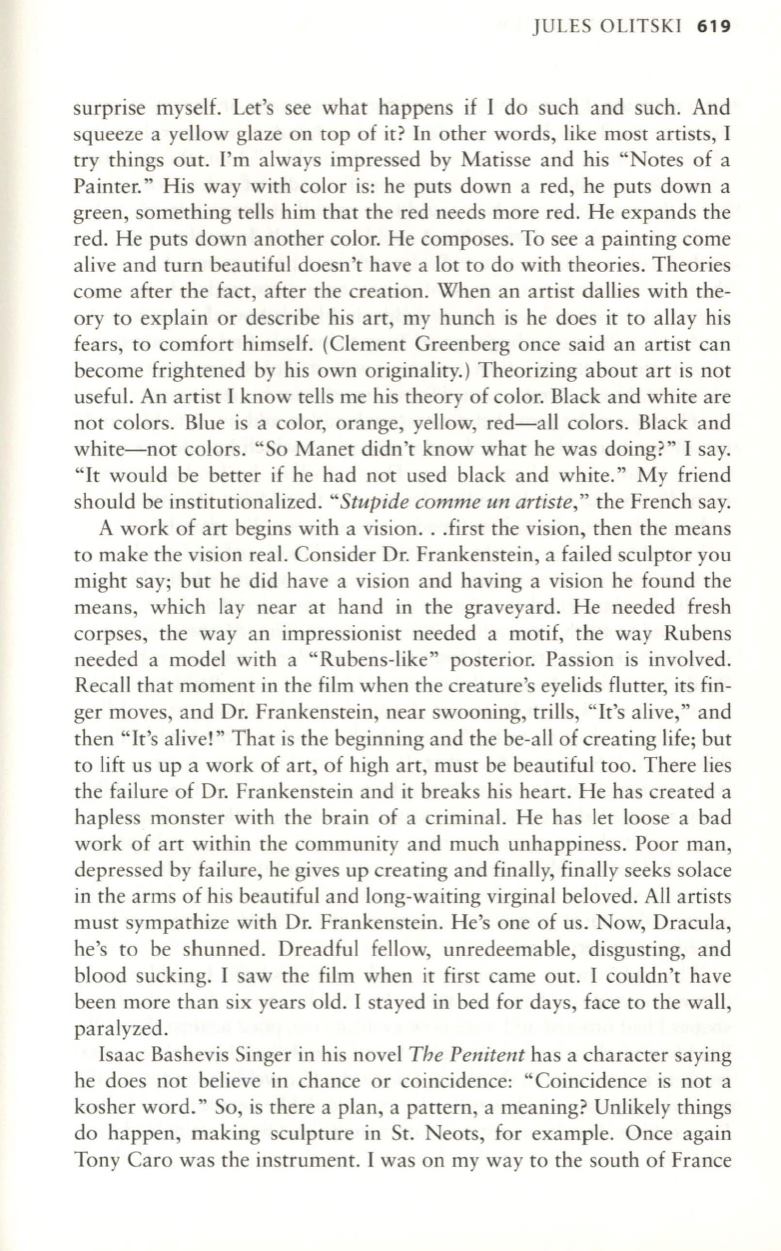
JULES OLITSKI
619
surprise myself. Let's see what happens if I do such and such. And
squeeze a yellow glaze on top of it? In other words, like most artists, I
try things out. I'm always impressed by Matisse and his "Notes of a
Painter." His way with color is : he puts down a red, he puts down a
green, something tells him that the red needs more red. He expands the
red. He puts down another color. He composes. To see a painting come
alive and turn beautiful doesn't have a lot to do with theories. Theories
come after the fact, after the creation. When an artist dallies with the–
ory to explain or describe his art, my hunch is he does it to allay his
fears, to comfort himself. (Clement Greenberg once said an artist can
become frightened by his own originality.) Theorizing about art is not
useful. An artist I know tells me his theory of color. Black and white are
not colors. Blue is a color, orange, yellow, red-all colors. Black and
white-not colors. "So Manet didn't know what he was doing?" I say.
"It would be better if he had not used black and white." My friend
should be institutionalized.
"Stupide comme un artiste,"
the French say.
A work of art begins with a vision . . .first the vision, then the means
to make the vision real. Consider Dr. Frankenstein, a failed sculptor you
might say; but he did have a vision and having a vision he found the
means, which lay near at hand in the graveyard . He needed fresh
corpses, the wayan impressionist needed a motif, the way Rubens
needed a model with a "Rubens-like" posterior. Passion is involved.
Recall that moment in the film when the creature's eyelids flutter, its fin–
ger moves, and Dr. Frankenstein, near swooning, trills, "It's alive," and
then "It's alive!" That is the beginning and the be-all of creating life; but
to lift us up a work of art, of high art, must be beautiful too. There lies
the failure of Dr. Frankenstein and it breaks his heart. He has created a
hapless monster with the brain of a criminal. He has let loose a bad
work of art within the community and much unhappiness . Poor man,
depressed by failure, he gives up creating and finally, finally seeks solace
in the arms of his beautiful and long-waiting virginal beloved. All artists
must sympathize with Dr. Frankenstein. He's one of us. Now, Dracula,
he's to be shunned. Dreadful fellow, unredeemable, disgusting, and
blood sucking. I saw the film when it first came out. I couldn't have
been more than six years old. I stayed in bed for days, face to the wall,
paralyzed.
Isaac Bashevis Singer in his novel
The Penitent
has a character saying
he does not believe in chance or coincidence: "Coincidence is not a
kosher word." So, is there a plan, a pattern, a meaning? Unlikely things
do happen, making sculpture in St. Neots, for example. Once again
Tony Caro was the instrument. I was on my way to the south of France


